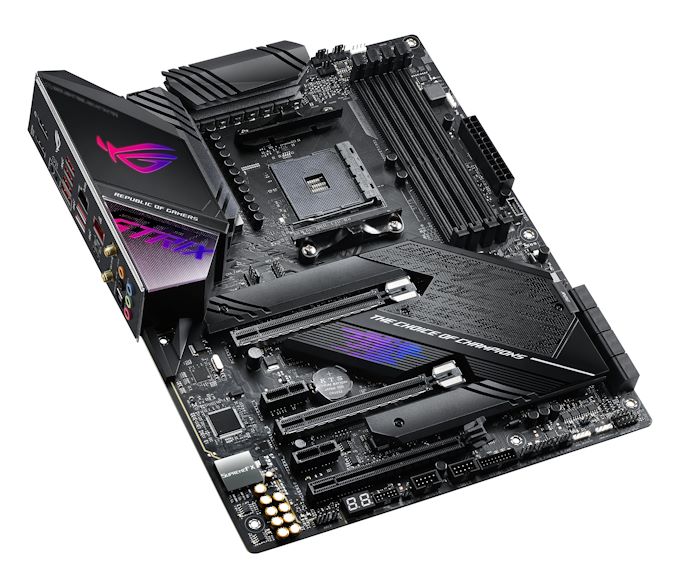The AMD X570 Motherboard Overview: Over 35+ Motherboards Analyzed
by Gavin Bonshor on July 9, 2019 8:00 AM ESTASUS ROG Strix X570-E Gaming
ASUS's Strix brand represents its more mid-range gaming focused offerings and the ASUS ROG Strix X570-E Gaming is one of two ATX sized Strix branded boards, with the X570-E being the more premium of the two models; the other being the slightly lower spec ASUS ROG Strix X570-F Gaming. Included is support for two-way NVIDIA SLI and up to three-way AMD CrossFire multi-graphics cards configurations, 2.5 Gigabit networking, and a Wi-Fi 6 wireless interface.
The ASUS ROG Strix X570-E includes the gaming-focused Realtek RTL8125G 2.5 Gigabit NIC with a second port controlled by an Intel I211-AT Gigabit NIC. The board's wireless capabilities come from the new Intel AX200 Wi-Fi 6 802.11ax adapter. The board boasts three full-length PCIe 4.0 slots which operate at x16, x8/x8, and x8/x8/x4, with the final four coming directly from the X570 chipset. The Strix themed chipset heatsink has two M.2 heatsinks emanating from the top and bottom side for the boards dual PCIe 4.0 M.2 and has a cooling fan integrated which is designed to keep the X570 chipset cool. The ROG Strix X570-E also has eight SATA ports and four DDR4 memory slots with support for up to 128 GB.
In terms of USB connectivity on the rear panel, there are three USB 3.1 G2 Type-A, one USB 3.1 G2 Type-C, and four USB 3.1 G1 Type-A ports. A SupremeFX S1220 HD audio codec powers the five color-coded 3.5 mm jacks, and an S/PDIF optical out, while a pair of video outputs consisting of an HDMI 2.0 and DisplayPort 1.2 output is featured. A handily located BIOS Flashback button and a single USB 3.1 G1 Type-A dedicated to this are clearly highlighted, and the ROG Strix X570-E also benefits from dual Ethernet ports with one being controlled by a Realtek RTL8125-CG 2.5 Gigabit NIC, while the other is driven by an Intel I1211-AT Gigabit NIC. There are also two antenna inputs for the Intel AX200 802.11ax Wi-Fi 6 wireless interface which also adds BT 5 connectivity into the mix.
The ASUS ROG Strix X570-E Gaming has an MSRP of $330 and represents its bridge between the mid-range and the higher end Crosshair VIII models. With Wi-Fi 6, 2.5 Gigabit + 1 Gigabit NICs and a SupremeFX S1220A HD audio codec and two-way NVIDIA SLI support, users looking for a high-quality ASUS X570 model may not have to look further than the Strix X570-F.












225 Comments
View All Comments
abufrejoval - Tuesday, July 9, 2019 - link
It's amazing how quickly you run out of PCIe lanes, when you don't have switches to multiplex and translate between PCIe revisions and lanes (e.g. PCIe v4 x2 <-> PCIe v2 x8).I find myself using USB 3.x NBase-T NICs and NVMe adapters, simply because they *do* switch.
Bensam123 - Tuesday, July 9, 2019 - link
Maybe a bit more depth on the power delivery page. I have absolutely no idea how to go about parsing what's there. More chokes is better? What denotes a power phase?A5 - Tuesday, July 9, 2019 - link
+1. Some analysis of that information would be helpful.MrSpadge - Tuesday, July 9, 2019 - link
+1bunkle - Wednesday, July 10, 2019 - link
The controller column includes the total number of phases supported split between CPU cores and SoC e.g. (6+1) = 6 CPU phase and 1 SoC phase. More is *usually* better but has diminishing returns regarding tighter and tighter voltage regulation. Some controllers are better than others (can operate at high frequency e.g. 500KHz v 1000KHz, include other features to improve performance) mitigating the need for more phases.Each phase is a buck converter comprised of a low/high side MOSFET (can be integrated in a single package) and choke. Some controllers can support doubling up the PWM signal to driver more MOSFETs. Doublers can also be added as discrete components if not built into the controller.
Current rating of the MOSFET (e.g. Sic639=40A IR3555=60A) indicates the total power deliverable. MOSFETs are not 100% efficient and vary in efficiency. The more current they provide the hotter they get and the less efficient they become, with better MOSFETs producing less heat for a given current. Thus using doubles can improve temperatures and efficiency without the benefits of the tighter voltage tolerance that *real* phases provide.
Hope that’s helpful!
bunkle - Wednesday, July 10, 2019 - link
A lot more detailed explanation: https://en.wikichip.org/wiki/voltage_regulator_mod...bug77 - Tuesday, July 9, 2019 - link
The description for AsRock X570(M) Pro4 says "5 jack + 1 SPDIF". Unfortunately, those boards lack SPDIF and only come with 3 jacks ;)Smell This - Tuesday, July 9, 2019 - link
I'm thinking the *ASRock Thunderbolt AIC* ...https://thunderbolttechnology.net/product/asrock-t...
would cover all your TBT peripheral needs, including optical.
DanNeely - Tuesday, July 9, 2019 - link
Do X570 boards still need an extra chip per USB port to support USB-C reversibility?The additional expense and needed PCB space were cited as among the reasons why earlier generation boards (IIRC both Intel and AMD) almost never had more than 1 C port; but it was never clear to me if that was an inherent implementation penalty for the C port or an artifact of Intel's tech stack being stalled out and AMD outsourcing to ASMedia which built the chipsets on an ancient (55nm) platform.
DigitalFreak - Tuesday, July 9, 2019 - link
Gavin - X370 and X470 only supported PCIe 2.0. The connection between the CPU and chipset was 3.0, but all the ports on the chipset were 2.0.